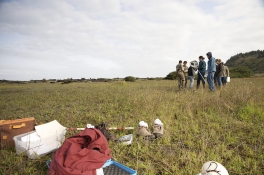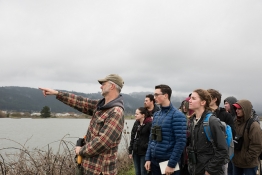Sydney McCluskey
ABSTRACT: Small mammal species play a critical role in forest ecosystems contributing significantly to overall forest biodiversity and ecological dynamics. Forest-dwelling species are among the most vulnerable to habitat loss and fragmentation. It is essential to develop efficient techniques for monitoring small mammal populations in forested ecosystems to inform conservation efforts and management plans; yet, monitoring small mammals in these habitats can be particularly challenging due to their size, activity patterns, and frequently nocturnal nature. In this study, I aimed to address two primary research objectives: 1) compare the effectiveness of 3 distinct camera-trap survey techniques (i.e., ground, tree, and tube) with traditional live trapping techniques for monitoring small mammal populations, and 2) elucidate the species composition of small mammals across old- and second-growth forest stands. Additionally, I assessed the effectiveness of the 3 different camera-trap techniques by comparing species richness and capture rates between methods. Surveys were conducted in 6 study areas within old- and second-growth coast redwood (Sequoia sempervirens) stands (3 areas within each stand type) from June to September 2020 in Headwaters Forest Reserve in northwestern California. Camera-trap methods recorded greater small mammal diversity (77% of total known species) compared to live-trap methods (46% of total known species), and also demonstrated significantly higher capture rates. Cameras also proved to be more cost-effective in the long term, reducing both labor and ethical costs compared with live-trap methods. A total of 10 small mammal species were detected by cameras out of the 13 known species during this study. Ten species were detected in second-growth stands and 8 species were detected in old-growth stands, with most species revealing an increase of “activity” (higher number of independent detections recorded) in old-growth stands. The tube camera method captured the greatest species richness (n = 10 species), followed by the tree method (n = 9 species) and ground method (n = 7 species); however, there was no significant difference in capture rates between camera methods. Capture rates were substantially different between live- and camera-trap methods, with more than 35 times the number of detections with camera-trap techniques. Camera-trap methods also detected more species (n = 10) compared with live-trap methods (n = 6). Findings from this study indicate that camera-trap techniques are more effective for detecting small mammal species in redwood forest ecosystems compared with live-trapping techniques, as well as being more cost-effective. This study further validates the efficacy of camera-trap techniques for monitoring small mammal species and deepens our understanding of small mammal ecology in redwood forest ecosystems and can help support informed decision-making for conservation and management strategies in fragmented forest landscapes.







